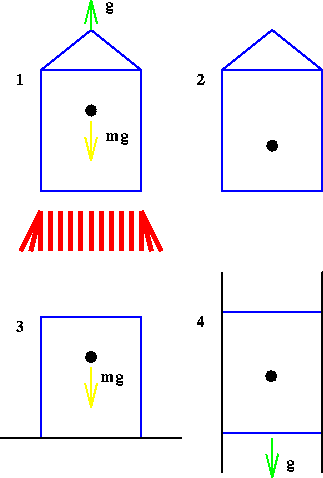One important property of an inertial frame is that a particle stays at rest or moves with uniform velocity unless it is acted on by a force [ Statement of Newton's first law ]. In the last section we discovered that bodies freely falling in a gravitational field all accelerate at the same rate regardless of their internal composition. It follows that relative to a non- rotating freely falling frame , at least locally, particles remain at rest or move in straight lines with uniform velocity, since this frame accelerates at the same rate as particles do. By locally we mean that observations are confined to a region over which the variation of the gravitational field is un- observably small. This leads to the following statement of the principle of equivalence .
Let us take the particular frame to be at rest when the photon
begins its upward journey and falls freely after that. Since the
photon rises a distance h, it takes a time ![]() to
arrive at the top. In this time, the frame has acquired a velocity
to
arrive at the top. In this time, the frame has acquired a velocity
![]() downward relative to the tower.
downward relative to the tower.
We can now use the redshift formula from section 2.2 to calculate the photon's frequency relative to the freely falling frame:

so

since we neglect terms of higher order [ as we did in section 2 ]. So there is no redshift in a freely falling frame thus confirming that it is a local inertial frame.
Einstein noted one other coincidence in Newtonian theory which
proved to be of great importance in formulating the principle of
equivalence. All inertial forces are proportional to the mass of the
body experiencing the force. There is one other force which behaves like
in the same way, that is the force of gravitation. For, if we drop
two bodies in the earths gravitational field, then they experience
forces ![]() and
and ![]() respectively. This coincidence suggested
to Einstein that the two effects should be considered as arising
from the same origin. Thus he suggested that we treat gravitation
as as inertial effect as well, in other words as an effect which
arises from not using an inertial frame. Comparing the force mg
of a falling body with the inertial force ma suggests the
following version of the principle of equivalence .
respectively. This coincidence suggested
to Einstein that the two effects should be considered as arising
from the same origin. Thus he suggested that we treat gravitation
as as inertial effect as well, in other words as an effect which
arises from not using an inertial frame. Comparing the force mg
of a falling body with the inertial force ma suggests the
following version of the principle of equivalence .
We consider an observer confined in a lift with no windows in it or other methods of communication with the outside world. The observer is allowed equipment to carry out simple dynamical experiments. The object of the exercise is to try and determine the observers state of motion. Let us consider four cases [ see Figure 5.4 ].

Clearly, from the point of view of the observer in the lift, cases 1 and 3 are indistinguishable, as required by POE 2, and cases 2 and 4 are indistinguishable, as required by POE 1.
This is the principle of equivalence between gravity and acceleration, and is a corner stone of the theory of General Relativity. In more modern terminology, what we have described is called the weak equivalence principle , ``weak'' because it refers only to gravity. We shall later use the strong equivalence principle , which says that one can discover how all the laws of physics behave in a gravitational field by postulating that their laws in a freely falling inertial frame are identical to their laws in Special Relativity i.e. when there are no gravitational fields.